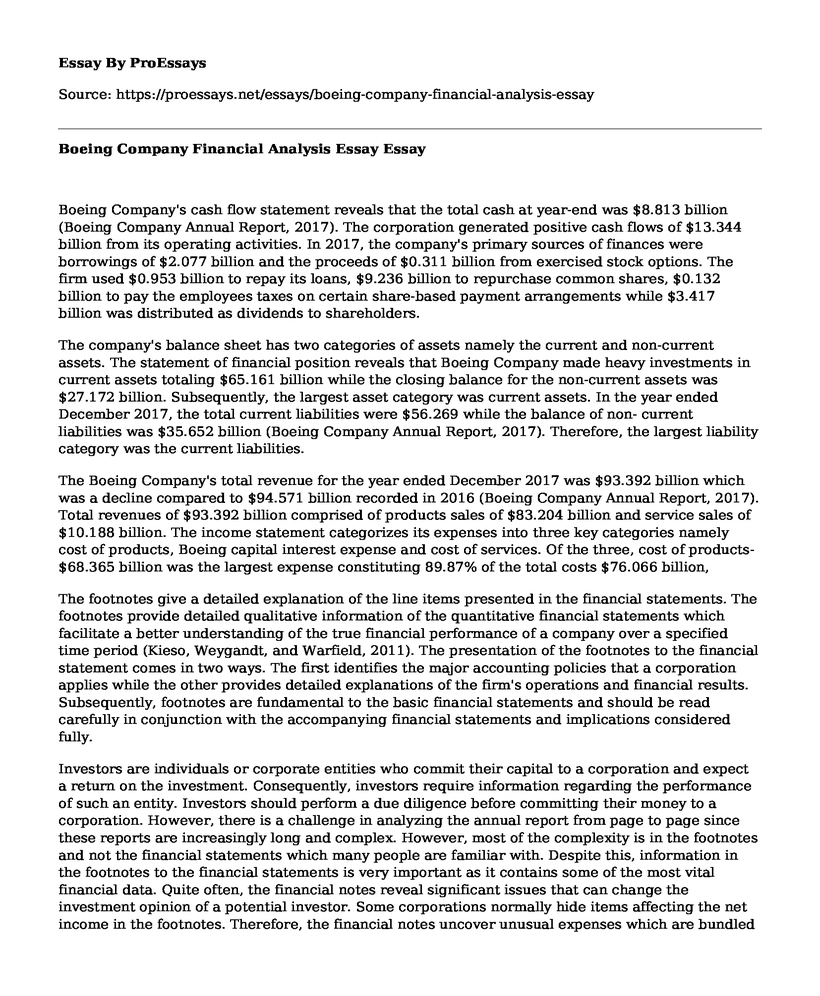Boeing Company's cash flow statement reveals that the total cash at year-end was $8.813 billion (Boeing Company Annual Report, 2017). The corporation generated positive cash flows of $13.344 billion from its operating activities. In 2017, the company's primary sources of finances were borrowings of $2.077 billion and the proceeds of $0.311 billion from exercised stock options. The firm used $0.953 billion to repay its loans, $9.236 billion to repurchase common shares, $0.132 billion to pay the employees taxes on certain share-based payment arrangements while $3.417 billion was distributed as dividends to shareholders.
The company's balance sheet has two categories of assets namely the current and non-current assets. The statement of financial position reveals that Boeing Company made heavy investments in current assets totaling $65.161 billion while the closing balance for the non-current assets was $27.172 billion. Subsequently, the largest asset category was current assets. In the year ended December 2017, the total current liabilities were $56.269 while the balance of non- current liabilities was $35.652 billion (Boeing Company Annual Report, 2017). Therefore, the largest liability category was the current liabilities.
The Boeing Company's total revenue for the year ended December 2017 was $93.392 billion which was a decline compared to $94.571 billion recorded in 2016 (Boeing Company Annual Report, 2017). Total revenues of $93.392 billion comprised of products sales of $83.204 billion and service sales of $10.188 billion. The income statement categorizes its expenses into three key categories namely cost of products, Boeing capital interest expense and cost of services. Of the three, cost of products-$68.365 billion was the largest expense constituting 89.87% of the total costs $76.066 billion,
The footnotes give a detailed explanation of the line items presented in the financial statements. The footnotes provide detailed qualitative information of the quantitative financial statements which facilitate a better understanding of the true financial performance of a company over a specified time period (Kieso, Weygandt, and Warfield, 2011). The presentation of the footnotes to the financial statement comes in two ways. The first identifies the major accounting policies that a corporation applies while the other provides detailed explanations of the firm's operations and financial results. Subsequently, footnotes are fundamental to the basic financial statements and should be read carefully in conjunction with the accompanying financial statements and implications considered fully.
Investors are individuals or corporate entities who commit their capital to a corporation and expect a return on the investment. Consequently, investors require information regarding the performance of such an entity. Investors should perform a due diligence before committing their money to a corporation. However, there is a challenge in analyzing the annual report from page to page since these reports are increasingly long and complex. However, most of the complexity is in the footnotes and not the financial statements which many people are familiar with. Despite this, information in the footnotes to the financial statements is very important as it contains some of the most vital financial data. Quite often, the financial notes reveal significant issues that can change the investment opinion of a potential investor. Some corporations normally hide items affecting the net income in the footnotes. Therefore, the financial notes uncover unusual expenses which are bundled into the income statement line items that can lower the net income. A company can be consistently profitable with attractive returns on capital and decent free cash flows however a review of the footnotes may reveal glaring problems for the firm, hence it is important for investors to review the accompanying notes to the financial report.
A review of the footnotes of Boeing's annual report has helped me gain a better understanding of accounting policies that the company uses and its operational and financial results. For instance, note 20 regarding legal proceedings highlights critical information regarding the firm's future which is essential. The note indicates that the corporation does not expect the outcomes of the cases to have a significant effect on the firm's operations, cash flows and financial position (Boeing Company Annual Report, 2017). Such information is critical as it reveals expectation about a firm's future. Also, the notes explain complex definitions and also gives breakdowns of the various specific line items hence improving my understanding of the Boeing's annual report.
References
Boeing Company. (2018). Boeing Company annual report 2017. Retrieved from http://s2.q4cdn.com/661678649/files/doc_financials/annual/2017/2017-Annual-Report.pdf
Kieso, D. E., Weygandt, J. J., & Warfield, T. D. (2011). Intermediate accounting. Hoboken, NJ: John Wiley & Sons.
Cite this page
Boeing Company Financial Analysis Essay. (2022, May 09). Retrieved from https://proessays.net/essays/boeing-company-financial-analysis-essay
If you are the original author of this essay and no longer wish to have it published on the ProEssays website, please click below to request its removal:
- Reducing the Budget Deficit Paper Example
- Common Stocks Essay Example
- Accounting for Derivatives Paper Example
- Sin Tax: Impact on Consumer Behavior & Habits - Research Paper
- Funding Sports/Festivals: Economic Impact and Misapplication - Research Paper
- Communication Dynamics: Embrace Change, Express Ideas More Efficiently
- Inheriting $$$: Investing in Government Securities & Real Estate - Essay Sample







